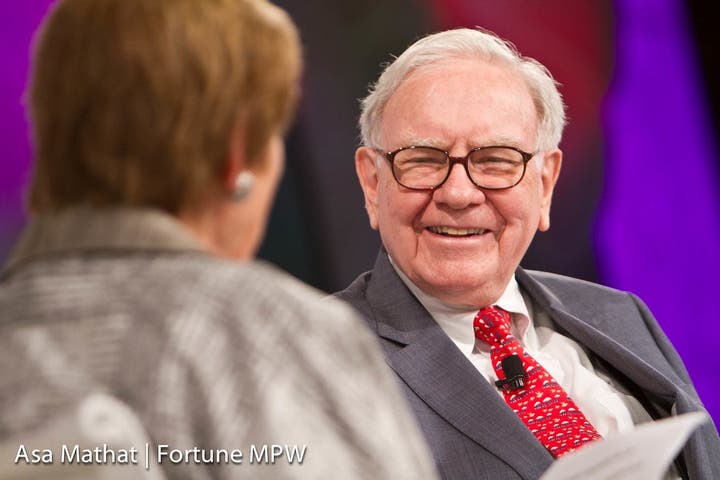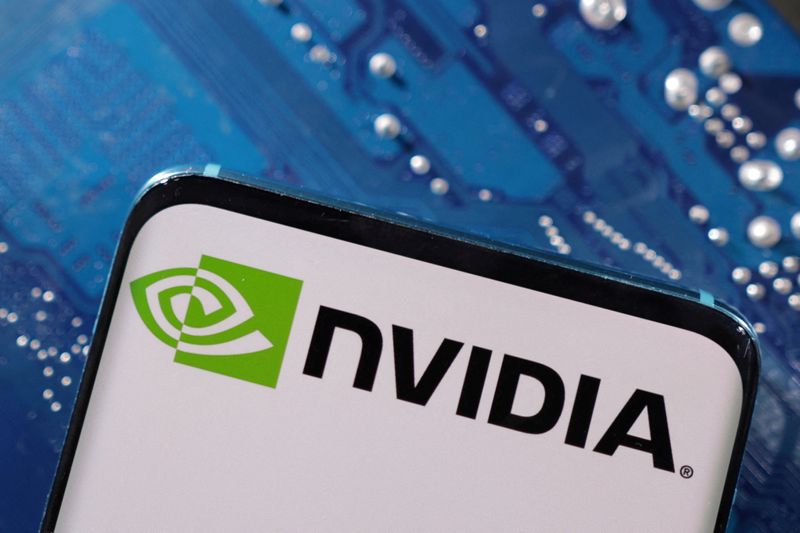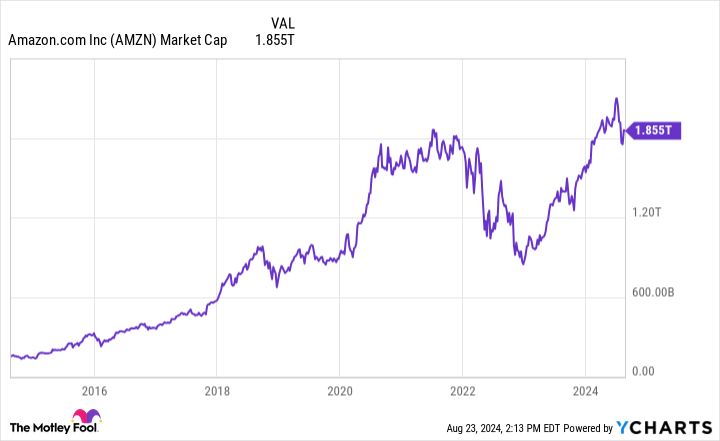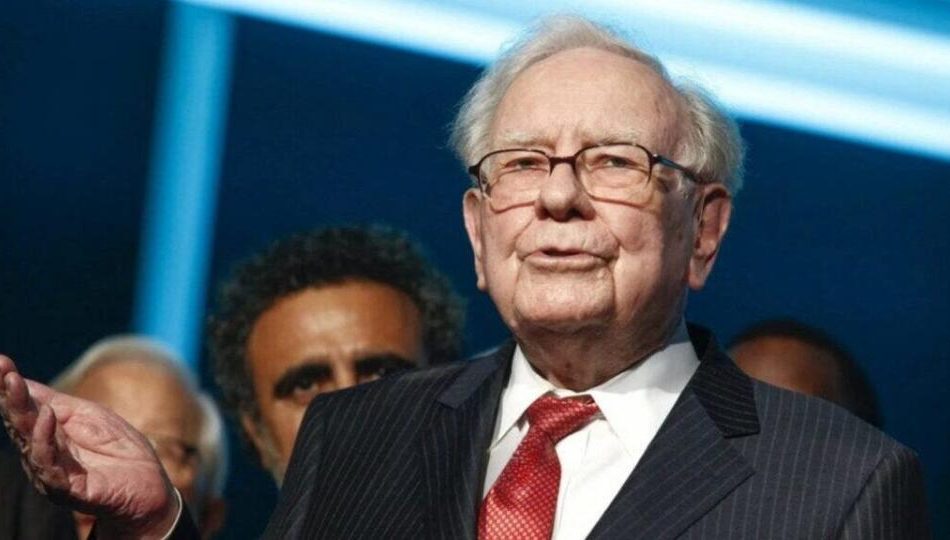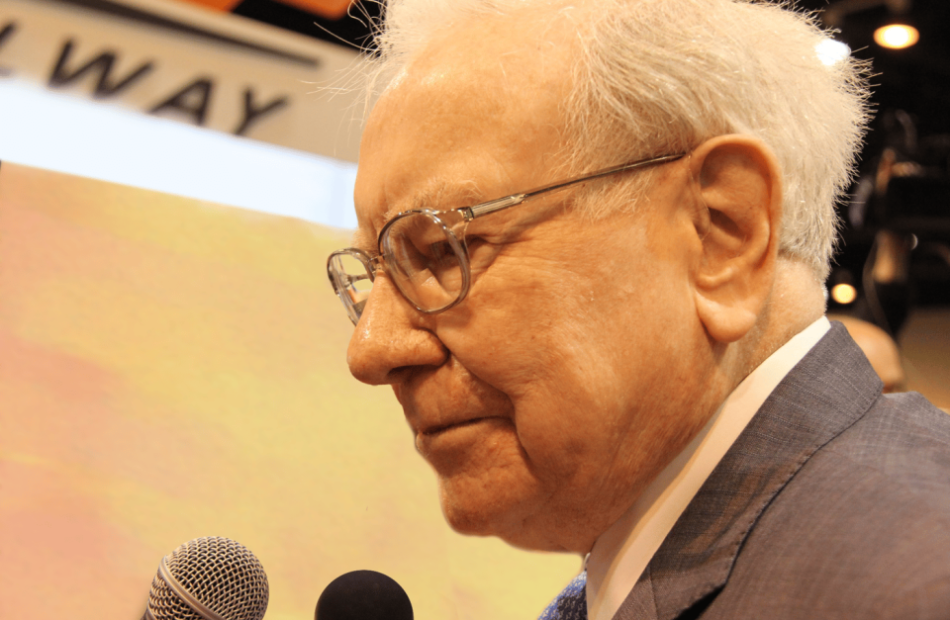Warren Buffett Shares Secrets To Making 'Very Significant Sums' With Small Investment — 'You Will Find Something, There's No Question About It'
Benzinga and Yahoo Finance LLC may earn commission or revenue on some items through the links below.
Warren Buffett continues to impress investors with his foresight and prescient stock-picking skills. How does he do it? Is there a secret behind Buffett’s investing style? Buffett is probably asked this question at nearly every annual Berkshire Hathaway meeting since they began decades ago.
We found an old recording of a Q&A session of a Berkshire Hathaway annual meeting, where Buffett was asked about something that’s extremely relevant to beginner investors today.
Check It Out:
-
A billion-dollar investment strategy with minimums as low as $10 — you can become part of the next big real estate boom today.
This is a paid advertisement. Carefully consider the investment objectives, risks, charges and expenses of the Fundrise Flagship Fund before investing. This and other information can be found in the Fund’s prospectus. Read them carefully before investing. -
This billion-dollar fund has invested in the next big real estate boom, here’s how you can join for $10.
This is a paid advertisement. Carefully consider the investment objectives, risks, charges and expenses of the Fundrise Flagship Fund before investing. This and other information can be found in the Fund’s prospectus. Read them carefully before investing.
Buffett’s 29% Returns Vs. Just 7% For The Dow
A listener mentioned that Buffett’s top performance came in from 1956 through 1969, when he returned 29% annually compared with just 7% for the Dow. He reminded Buffett that back in the day his investing approach was to look at many undervalued stocks with “less attention” to long-term economics and sell them quickly. However, according to the fan, Buffett later changed his approach to investing in undervalued companies with strong businesses and holding on to them for the long term. He asked the Oracle of Omaha his key question:
“If you are investing a small sum today, which approach would you use?”
What Would Buffett Do In Today’s Market With A Small Investment?
Here’s how Buffett started his response:
“I would use the approach that I think I am using now of trying to search out businesses where I think they are selling at the lowest price relative to the discounted cash that they would produce in the future.”
The Benefit Of Having A Small Investment
Buffett said more than once during his response that having a small amount of money to invest expands the “universe” of potential opportunities and “ideas.”
Buffett’s Performance Was 37 Points Better Than The Dow In A Decade
The audience member mentioned that Buffett’s best returns came between 1956 through 1969.
Buffett corrected the listener, saying his best performance was before that.
“From right after I met Ben Graham in early 1951, but from the end of 1950 through the next ten years, actual returns averaged about 50% a year and I think they were 37 points better than the Dow, or something like that.”
Buffett’s Process of Investing $10,000 – $15,000 In A Company
How was Buffett able to post those returns? He said that at that time he was working with a “tiny, tiny, tiny” amount of money.
“So I would pour through volumes of businesses and I would find one or two that I could put $10,000 or $15,000 into; they were ridiculously cheap.”
Buffett said that as the money increased over time, the “universe of possible ideas” started shrinking “dramatically.”
He also said that those times were also “better” in terms of investments.
Buffett Says You Can Still Make “Very Significant Sums”
“If you are working with a small amount of money, with exactly the same background that Charlie and I have, the same ideas, same whatever ability we have, you know I think you could make very significant sums.”
Buffett repeated that as soon as the money goes into “millions” or “many millions,” the curve of returns “falls off” quickly.
Keep Reading:
How Did Buffett Find Undervalued Companies?
Buffett also said that when you have opportunities in which you’d put millions, there would be a lot of competition. The billionaire also emphasized the importance of doing hard work.
“When I started, I went through the pages of the manuals, page by page, I might have gone through 20,000 pages in the Moody’s industrials, transportation, banks and finance manuals. And I did it twice.”
However, Buffett said that this method would not be practical when you are investing millions of dollars.
“You Will Find Some Things”
“If you are working with a small sum of money, and you are really interested in the business and willing to do the work, you will find something. There’s no question about it. You will find some things that promise very large returns compared to what we will be able to deliver with large sums of money.”
Charlie Munger’s Advice: Look For “Obscure” Stocks
After this comment, Buffett requested Charlie Munger to share his thoughts on the topic. Munger agreed with Buffett and said if you have a limited amount of capital, you should be looking at “obscure stocks” and “unusual mispriced” opportunities.
Buffett said that during bull markets some people begin to think that making money in the stock market is easy. He said that he knew some people starting hedge funds while based on their track record and ability they should be “mowing lawns.”
Lock In High Rates Now With A Short-Term Commitment
Leaving your cash where it is earning nothing is like wasting money. There are ways you can take advantage of the current high interest rate environment through private market real estate investments.
EquityMultiple’s Basecamp Alpine Notes is the perfect solution for first-time investors. It offers a target APY of 9% with a term of only three months, making it a powerful short-term cash management tool with incredible flexibility. EquityMultiple has issued 61 Alpine Notes Series and has met all payment and funding obligations with no missed or late interest payments. With a minimum investment of $5,000, Basecamp Alpine Notes makes it easier than ever to start building a high-yield portfolio.
Looking for fractional real estate investment opportunities? The Benzinga Real Estate Screener features the latest offerings.
This article Warren Buffett Shares Secrets To Making ‘Very Significant Sums’ With Small Investment — ‘You Will Find Something, There’s No Question About It’ originally appeared on Benzinga.com
2 Monster Growth Stocks to Buy Before Sales Soar 94% and 136%, According to Wall Street
Stocks are often valued based on earnings or cash flow, but both metrics are ultimately limited by sales. For that reason, strong sales growth often goes hand-in-hand with share-price appreciation, and analysts anticipate strong sales growth from Shopify (NYSE: SHOP) and Cloudflare (NYSE: NET) in the coming years.
-
Shopify reported $7.7 billion in revenue during the last 12 months. Wall Street expects sales to increase 94% to $14.9 billion in 2027, implying annual growth of 21%.
-
Cloudflare reported $1.48 billion in revenue during the last 12 months. Wall Street expects sales to increase 136% to $3.5 billion in 2027, implying annual growth of 28%.
Read on to learn more about these monster growth stocks.
1. Shopify
Shopify is the market leader in e-commerce software, and its enterprise-grade platform Shopify Plus is the leading omnichannel-commerce software. That success stems from its ability to simplify retail. Shopify provides a turnkey solution that lets merchants build and manage their businesses across physical and digital storefronts. It also provides adjacent services for payments, marketing, and logistics.
Shopify reported excellent financial results in the second quarter, beating expectations on the top and bottom lines. Revenue increased 20% to $2 billion driven by particularly strong growth in subscription-software sales, though merchant-services sales also climbed at a steady clip. Meanwhile, non-GAAP net income surged 94% to $345 million.
Investors have good reason to believe Shopify can maintain its momentum. Management estimates its addressable market at $849 billion. The company is well positioned to capitalize on that opportunity given that Shopify merchants account for 10% of online retail sales in the United States and 6% of online retail sales in Western Europe.
Additionally, investments in more sophisticated tools — custom-storefront capabilities, wholesale-commerce features, machine learning-driven market software — targeting larger brands are paying off. For instance, gross merchandise volume (GMV) from wholesale-commerce features rose 140% in Q2 driven by more merchants adopting Shopify Plus. That is noteworthy because the wholesale e-commerce market is growing faster than retail e-commerce.
As mentioned, Wall Street expects Shopify to grow sales at 21% annually through 2027. That estimate makes the current valuation of 12.6 times sales seem fair despite being a premium to the two-year average of 11.4 times sales. Investors with a time horizon of at least three years should consider buying a small position in this growth stock today.
2. Cloudflare
Cloudflare provides a range of cloud services that accelerate and protect IT infrastructure, while eliminating the cost and complexity of on-premises network hardware. Specifically, its portfolio comprises application performance and security services, zero trust network-security services, and developer tools. Engineering expertise and scale have helped the company secure a strong presence across all three verticals.
To elaborate, Cloudflare operates the fastest cloud network on the planet, and it powers about 20% of the web. That affords the company deep insight into performance issues and security threats across the internet, creating a network effect whereby each new data point enhances its ability to route traffic quickly and securely.
Industry analysts have praised Cloudflare for its technology. For instance, the International Data Corp. has recognized its leadership in content-delivery network software and zero trust network access, and Forrester Research has named the company a leader in edge-development platforms. Those accolades tell potential customers Cloudflare is worth consideration.
The company reported solid financial results in Q2. Its customer count rose 21% to surpass 210,000, and existing customers spent 12% more. In turn, revenue climbed 30% to $401 million, and non-GAAP net income soared 106% to $69 million.
Investors have good reason to believe that momentum will continue. Cloudflare has hardly dented its $176 billion addressable market, and investments in go-to-market capabilities are bearing fruit. Management said sales productivity showed double-digit improvement during the quarter.
As mentioned, Wall Street expects the company’s sales to grow at 28% annually through 2027. That makes the current valuation of 18.7 times sales seem reasonable, especially when the two-year average is 19.5 times sales. Investors with a time horizon of at least three years should consider buying a small position in Cloudflare stock today.
Should you invest $1,000 in Shopify right now?
Before you buy stock in Shopify, consider this:
The Motley Fool Stock Advisor analyst team just identified what they believe are the 10 best stocks for investors to buy now… and Shopify wasn’t one of them. The 10 stocks that made the cut could produce monster returns in the coming years.
Consider when Nvidia made this list on April 15, 2005… if you invested $1,000 at the time of our recommendation, you’d have $774,894!*
Stock Advisor provides investors with an easy-to-follow blueprint for success, including guidance on building a portfolio, regular updates from analysts, and two new stock picks each month. The Stock Advisor service has more than quadrupled the return of S&P 500 since 2002*.
*Stock Advisor returns as of August 26, 2024
Trevor Jennewine has positions in Shopify. The Motley Fool has positions in and recommends Cloudflare and Shopify. The Motley Fool has a disclosure policy.
2 Monster Growth Stocks to Buy Before Sales Soar 94% and 136%, According to Wall Street was originally published by The Motley Fool
Mark Cuban Invests $400K In Company He Doesn't Understand — Because His Daughters Do
Mark Cuban invested more than $20 million in companies during his time on “Shark Tank,” a show he will be leaving after the upcoming 16th season.
Cuban was known for his quick bids and exits, sometimes offering to buy companies outright for products he believed in. During a 2023 episode in season 14, Cuban broke one of his investing rules for the show.
Don’t Miss:
What Happened: Cuban typically invests in companies offering products he can envision himself using or that might benefit the Dallas Mavericks, the NBA team he partly owns.
However, in a 2023 episode of “Shark Tank,” Cuban made an offer for a company whose products he likely won’t ever personally use.
In Season 14, Episode 15 of “Shark Tank,” which aired in early March, makeup brand Youthforia presented its pitch.
Youthforia, founded in April 2021, had already achieved $2 million in sales before appearing on the show, as reported by CNBC. The brand gained significant traction on TikTok, particularly for its color-changing oil blush that adjusts to match and blend with customers’ skin tones. On TikTok, Youthforia boasts over 130,000 followers and more than three million likes.
Trending: General Motors and other leaders revealed to be investing in this revolutionary lithium start-up — allowing easy entry by launching at just $9.50/share with a $1,000 minimum.
The Sharks liked the TikTok success and were also impressed with the company’s founder and CEO Fiona Co Chan.
Kevin O’Leary offered Co Chan $100,000 for 20% of the company along with a $300,000 loan and a cut of distribution pay.
“It’s a bet on the jockey on this deal,” O’Leary said of Co Chan. “You’re really impressive.”
Co Chan wanted to hear from the other Sharks, with Cuban and Barbara Corcoran not putting out bids yet. Co Chan tried to lure them in by saying there was a launch of more shades of blush coming, which neither was thrilled about.
Trending: This startup’s stem cell research aims to reduce reliance on animal testing — Sees 55% uptick in YTD sales and only costs $3 per share for early investors.
“When you have something that’s completely differentiated, you ride that, and you don’t do anything else, because that just dilutes your efforts,” Cuban said. “Sometimes, you shouldn’t listen to your customers.”
Co Chan turned to O’Leary and offered 5% equity for $400,000 and a 50 cent royalty for each unit sold by the company up to $500,000.
O’Leary countered with an $800,000 offer for 10% equity and a $1 royalty on each unit.
Trending: Elon Musk and Jeff Bezos are bullish on one city that could dethrone New York and become the new financial capital of the US. Investing in its booming real estate market has never been more accessible.
This is when Cuban decided to step in, offering $400,000 for 10% without a royalty and said the reason he was interested in the makeup brand was because his daughters and wife would “understand” the product, which he didn’t.
Cuban offered to wear the color-changing blush himself as part of demos.
O’Leary countered with a $400,000 offer for 7.5% and a 75 cent royalty on sales up to $1 million.
Ultimately, Cuban got Co Chan to accept with his final offer of $400,000 for 8% and no royalties, which he offered “just to prove a point” and ended up beating O’Leary.
Did You Know?
Why It’s Important: The company and Co Chan drew praise from the Sharks during portions of the pitch and after Cuban’s offer was accepted.
Herjavec and Corcoran, who sat out on the offers, said they were impressed with Co Chan’s negotiating skills.
“Kevin, you have to get up and leave the ‘Shark Tank,'” Herjavec said. “Fiona’s taking your chair.”
The offer for Youthforia that was accepted makes the first deal Cuban has ever done with a makeup brand, which could provide several lessons. Cuban has often stuck to his principles in investing in products that he would use himself or the Mavericks would use.
Hearing how much the other Sharks loved the company’s CEO and the product going viral on TikTok, Cuban trusted in his family and made the investment because he could see his daughters and wife using the product.
Youthforia is available on Amazon.com and also at Ulta Beauty (NASDAQ:ULTA) stores. While we won’t likely see the makeup products at Mavericks games in the future, they could end up becoming a staple in the Cuban household.
This article was previously published by Benzinga on Benzinga Inspire and has been updated.
Check This Out:
“ACTIVE INVESTORS’ SECRET WEAPON” Supercharge Your Stock Market Game with the #1 “news & everything else” trading tool: Benzinga Pro – Click here to start Your 14-Day Trial Now!
Get the latest stock analysis from Benzinga?
This article Mark Cuban Invests $400K In Company He Doesn’t Understand — Because His Daughters Do originally appeared on Benzinga.com
© 2024 Benzinga.com. Benzinga does not provide investment advice. All rights reserved.
Nvidia's forecast dampens AI enthusiasm in other tech stocks
By Noel Randewich and Saqib Iqbal Ahmed
(Reuters) -Shares of Nvidia and other technology heavyweights fell late on Wednesday, a discouraging sign for investors betting that a strong forecast from the dominant seller of AI chips would fuel fresh gains in Wall Street’s most valuable companies.
Nasdaq futures fell about 1% following Nvidia’s quarterly earnings report, suggesting traders expect tech stocks to lose ground on Thursday.
Nvidia dropped almost 7% and lost $200 billion in stock market value after it forecast third-quarter gross margins that could miss market estimates and revenue that was largely in line. A handful of other AI-related companies shed around $100 billion in combined value.
Shares of Broadcom and Advanced Micro Devices were each down about 2%. Microsoft and Amazon each dipped almost 1%.
If Wednesday’s late-day dip in Nvidia shares extends into Thursday, it would be well short of the 11% price swing the options market had priced for the shares, according to data from options analytics firm ORATS.
Surging demand for its AI chips helped Nvidia crush consensus analyst estimates for several quarters, a trend that led investors to expect the company to exceed forecasts by higher and higher margins.
Nvidia’s soft forecasts overshadowed a beat on second-quarter revenue and adjusted earnings as well as the unveiling of a $50 billion share buyback.
“They beat but this was just one of those situations where expectations were so high. I don’t know that they could have had a good enough number for people to be happy,” said JJ Kinahan, CEO of IG North America and president of online broker Tastytrade.
The lackluster response to Nvidia’s earnings report could help set the tone for market sentiment heading into what is historically a volatile time of the year. The S&P 500 has fallen in September by an average of 0.8% since World War Two, the worst performance of any month, according to CFRA data.
Investors are also watching next week’s U.S. employment report for signs on whether the labor market weakness that roiled stocks in early August has dissipated.
Optimism about AI technology, in part due to Nvidia’s explosive growth, has fueled gains on Wall Street over the past year.
However, confidence in that rally has wavered in recent weeks following an earnings season that saw investors punish shares of tech companies whose results failed to justify rich valuations.
Investors have also become concerned about increases in already hefty spending by Microsoft, Alphabet and other major players in the race to dominate emerging AI technology. Microsoft and Alphabet’s stocks remain down since their reports last month.
Nvidia forecast revenue of $32.5 billion, plus or minus 2%, for its fiscal third quarter, compared with analysts’ average estimate of $31.8 billion, according to LSEG data. That revenue forecast implies 80% growth from the year-ago quarter.
The Santa Clara, California-based company expects adjusted gross margin of 75%, plus or minus 50 basis points, in the third quarter. Analysts on average forecast gross margin to be 75.5%, according to LSEG data.
Nvidia’s stock dropped 2.1% in Wednesday’s session, ahead of its report. It remains up about 150% so far in 2024, making it the biggest winner in Wall Street’s AI rally.
Nvidia’s stock was valued at 36 times earnings ahead of its quarterly report, inexpensive compared to its average of 41 over the past five years. The S&P 500 is trading at 21 times expected earnings, compared to a five-year average of 18.
(Reporting by Noel Randewich in San Francisco; Additional reporting by Saqib Ahmed in New York; Editing by Ira Iosebashvili and Lisa Shumaker)
DJT sinks to new low: Why Trump Media investors are feeling less bullish
As a trading concern, Donald Trump’s social media company has become a way for investors to bet on the former president’s odds of retaking the White House.
Since going public through a special-purpose acquisition company merger in March, shares of Trump Media & Technology Group have fluctuated wildly alongside its namesake’s political fortunes.
Following Vice President Kamala Harris’ ascension to the top of the Democratic ticket, Trump has slipped in the polls and so, too, have shares of Trump Media, which owns the GOP nominee’s social media bullhorn of choice, Truth Social.
The stock drifted to a new post-merger low Tuesday, closing at $20.99. In the last 30 trading days, it has lost more than 40% of its value.
What happens if Trump sells DJT shares
In regulatory filings, Trump Media has telegraphed how critical Trump is to the company’s brand, warning that its value “may diminish” if Trump’s popularity falters.
Now another factor is weighing on the stock. Trump is less than a month away from being able to cash out his paper wealth. Trump Media has also cited Trump’s divestment of DJT stock as one of the top risks to its business.
Trump Media is a major contributor to Trump’s net worth. Its market value is hovering around $4 billion even though the company is losing money and has nearly no revenue.
Your wallet, explained. Sign up for USA TODAY’s Daily Money newsletter.
Trump owns about 60% of the company’s outstanding stock. He is expected to be able to start selling shares as soon as Sept. 20 when a six-month lockup period that has prevented insiders from unloading their holdings is expected to lift.
Trump has not indicated if he intends to sell shares in Trump Media and his campaign declined to comment.
Cashing in shares could help Trump pay his mounting legal bills but could antagonize supporters who have shoveled money into the stock and could be viewed as a vote of no confidence in the company.
The prosecutor in Trump’s federal election interference case secured a new indictment against Trump on Tuesday.
What more Trump Media shares mean for investors
Another key factor in the Trump Media stock decline is a deal Trump Media reached in July with Yorkville Advisors to register and sell up to $2.5 billion worth of new shares, says University of Florida finance professor Jay Ritter.
On the one hand, the deal could boost cash per share on the company’s balance sheet from $1.50 per share to about $4.50 per share, Ritter said.
“This increase would reduce the downside potential for the stock,” he said.
But there’s a caveat.
“Any upside for the company is dependent on coming up with a business strategy to generate revenue and profits,” Ritter said. “So far, the company has failed to find a successful strategy.”
What’s more, additional shares issued through the Yorkville agreement could be putting downward pressure on the stock price, according to Ritter.
Even if Trump does not sell shares when the lock-up period ends, other insiders may, increasing the public float even more, he added.
“The price might be drifting down partly in anticipation of these share sales,” Ritter said.
This article originally appeared on USA TODAY: DJT decline: Why Trump Media is falling out with investors
Prediction: This Unstoppable Hypergrowth Company Will Be the First $10 Trillion Stock (Hint: It's Not Nvidia)
In the last 10 years, we’ve seen the markets hit some major numerical milestones from a market-capitalization perspective. Apple was the first trillion-dollar market-cap company back in 2018. The other “Magnificent 7” stocks — so coined by Bank of America chief investment strategist Michael Hartnett as Apple, Alphabet, Amazon (NASDAQ: AMZN), Meta Platforms, Microsoft, Nvidia, and Tesla — soon followed. Now, Apple, Microsoft, and Nvidia all trade at market caps above $3 trillion. That is a lot of moola.
The next big milestone will be a market cap of $10 trillion. Let the race begin today between the technology giants. Even though it is starting well behind some of the other Magnificent 7 stocks, I predict Amazon will be the first company to hit a market cap of $10 trillion. Here’s why.
E-commerce has plenty of room to run
Amazon and its sprawling e-commerce empire are well-known. Looking at its North America segment — which also houses segments such as hardware and advertising — revenue hit $370 billion over the last 12 months ending in June of this year. Even though it has been around for so long and has many detractors in the media and government, Amazon is set to surpass 40% market share of U.S. e-commerce sales this year.
If Amazon can just maintain market share in the category, there is a ton of room for North American revenue to grow over the next five to 10 years. E-commerce is only 16% of retail sales in the United States today. If that eventually doubles to 32%, Amazon’s North American annual revenue will hit $740 billion.
With high-fixed costs across its e-commerce supply chain, more revenue will lead to profit-margin expansion. There will also be benefits from fast growing advertising services and third-party seller revenue, which are becoming a larger piece of the Amazon retail pie. Over the last 12 months, Amazon’s operating margin in North America was 5.6% and keeps marching higher. In the next 10 years, I think this segment can surpass a 15% operating margin.
A 15% operating margin on $740 billion in revenue is $111 billion in operating earnings just from the North American retail segment. Remember this number.
Cloud computing and AI
On the other hand, Amazon has perhaps an even more promising division in Amazon Web Services (AWS). The leader in cloud computing is close to passing $100 billion in annual revenue and posts impressive profit margins above 30%. It is riding a wave of growth in artificial intelligence (AI) at the moment but aims to be the computing bedrock for all sorts of modern software and other applications.
Like e-commerce, the world is still in the early days of transitioning to cloud computing. On the latest conference call, executives reiterated that the “vast majority” of IT spending is still on-site. They believe it will eventually switch to cloud-computing solutions, which will benefit AWS.
AWS revenue is growing at close to 20% year over year right now. If this slows to an average of 15% per year over the next 10 years, the division will eventually generate $400 billion in annual revenue, which isn’t a crazy assumption given that global IT spending is in the trillions and growing as a sector year after year.
Assuming operating margins stay at 30% or above, $400 billion in revenue equals $120 billion in operating income from AWS 10 years from now.
AMZN Market Cap data by YCharts.
The path to $10 trillion (and don’t forget international growth)
Long story short, I think Amazon is the most likely company to hit a $10 trillion market cap due to the huge runway for growth in the e-commerce and cloud-computing sectors. This is an unmatched tailwind across even other Magnificent 7 stocks, which look closer to market saturation.
Now to the math that leads to a $10 trillion valuation. Add together $120 billion in earnings from AWS and $111 billion in earnings from North America, and Amazon will have a combined $231 billion in earnings 10 years from now. But don’t forget the third pillar of Amazon’s business: international retail. The segment generates $136 billion in revenue but has negligible profits due to exposure to emerging markets such as India.
As an earnings headwind today, markets such as India can be a huge growth driver if India’s GDP per capita keeps growing at an impressive rate. A lot needs to go right in these other countries, but it is possible that the international segment can generate hundreds of billions in revenue and tens of billions in operating earnings 10 years from now if it can achieve similar profit margins as in North America.
Add it all together, and I think Amazon has a chance at generating $300 billion in earnings 10 years from now. At a price-to-earnings ratio (P/E) of 33 — not unheard of for large technology stocks — $300 billion in earnings equates to a $10 trillion market capitalization.
I know that is a lot of math, but this is the path for Amazon hitting the next market-cap milestone and winning the race to become the largest company in the world. Regardless of how fast it gets there, the stock looks like a buy-and-hold investment at a market cap of $1.86 trillion today.
Should you invest $1,000 in Amazon right now?
Before you buy stock in Amazon, consider this:
The Motley Fool Stock Advisor analyst team just identified what they believe are the 10 best stocks for investors to buy now… and Amazon wasn’t one of them. The 10 stocks that made the cut could produce monster returns in the coming years.
Consider when Nvidia made this list on April 15, 2005… if you invested $1,000 at the time of our recommendation, you’d have $774,894!*
Stock Advisor provides investors with an easy-to-follow blueprint for success, including guidance on building a portfolio, regular updates from analysts, and two new stock picks each month. The Stock Advisor service has more than quadrupled the return of S&P 500 since 2002*.
*Stock Advisor returns as of August 26, 2024
Randi Zuckerberg, a former director of market development and spokeswoman for Facebook and sister to Meta Platforms CEO Mark Zuckerberg, is a member of The Motley Fool’s board of directors. John Mackey, former CEO of Whole Foods Market, an Amazon subsidiary, is a member of The Motley Fool’s board of directors. Suzanne Frey, an executive at Alphabet, is a member of The Motley Fool’s board of directors. Brett Schafer has positions in Alphabet and Amazon. The Motley Fool has positions in and recommends Alphabet, Amazon, Apple, Meta Platforms, Microsoft, Nvidia, and Tesla. The Motley Fool recommends the following options: long January 2026 $395 calls on Microsoft and short January 2026 $405 calls on Microsoft. The Motley Fool has a disclosure policy.
Prediction: This Unstoppable Hypergrowth Company Will Be the First $10 Trillion Stock (Hint: It’s Not Nvidia) was originally published by The Motley Fool
US Mortgage Rates Drop Again to Lowest Level Since April 2023
(Bloomberg) — US mortgage rates fell again last week to the lowest level since April 2023, spurring a modest pickup in applications to buy a home.
Most Read from Bloomberg
The contract rate on a 30-year fixed mortgage eased for a fourth week to 6.44%, the longest stretch of declines this year, according to Mortgage Bankers Association data released Wednesday. That provided a small boost to home-purchase applications in the week ended Aug. 23 after a sizable drop in the prior period.
Mortgage rates move in tandem with Treasury yields, which have been falling recently on expectations the Federal Reserve will start cutting interest rates in September. Minutes of the central bank’s July meeting last week indicated “several” officials saw a case for reducing rates at the time, and Chair Jerome Powell said Friday “the time has come for policy to adjust.”
A further decline in borrowing costs is seen helping provide a spark for the housing market. But the weak level of purchases indicates that affordability challenges, due in part to high home prices, are holding prospective buyers.
The MBA survey, which has been conducted weekly since 1990, uses responses from mortgage bankers, commercial banks and thrifts. The data cover more than 75% of all retail residential mortgage applications in the US.
(Adds graphic)
Most Read from Bloomberg Businessweek
©2024 Bloomberg L.P.
Ask an Advisor: How Can We Avoid Capital Gains Tax on a House We're Inheriting?
My spouse will inherit her father’s house outright upon death and wants to sell it immediately. Would she be subjected to capital gains tax (above the $250,000 exclusion) on the sale and would it matter if only she is on the deed? Or would it make sense to have both of us on the deed to get the $500,000 exclusion for filing jointly?
– Kenneth
The short and simple answer is that you likely will not owe any capital gains tax when you sell the property that your wife is inheriting from her dad. However, it doesn’t really have anything to do with the capital gains exclusion you mention or whether you are both on the deed. A tax provision known as the “stepped-up basis” is what will help you potentially avoid capital gains tax.
I think this situation presents an interesting discussion. Let’s see what’s at play here. (And if you have similar questions or others related to financial planning and investing, consider connecting with a financial advisor.)
Capital Gains Exclusion on Property Sales
You are correct that the IRS lets individuals exclude up to $250,00 in profits from the sale of a primary residence from taxes. Married couples filing their taxes jointly can exclude up to $500,000. In other words, you can “make” that much money on the sale of your home without getting a tax bill.
For a simplified example, let’s say a couple buys a house for $500,000. They can sell it for up to $1 million without owing anything on that gain. If their capital gains exceed $500,000, they would owe taxes on the excess profit. This example is very simplified because it assumes the purchase price is the couple’s exact cost basis and ignores transaction costs like real estate agent fees that can reduce the gain.
However, this exemption doesn’t apply to all property sales. In order to qualify for the exemption:
-
The home must be the person or couple’s primary residence for at least 24 of the previous 60 months
-
They must have owned the home for at least two years.
Whether or not both people in the couple are on the deed is irrelevant. In fact, only one of them has to satisfy the requirements listed above. Your tax filing status determines whether the $250,000 or $500,000 exclusion applies. Again, single filers get the $250,000 exemption, while married couples filing jointly receive the $500,000 exclusion. (And if you need help with similar tax planning scenarios, consider speaking with a fiduciary financial advisor.)
Stepped-up Basis on Inherited Property
If you sell the property immediately, you obviously won’t qualify for the capital gain exclusion described above. You’ll be fully on the hook for the tax liability on any gains you make when you sell the property.
However, your gain will likely be $0 or very close to it, regardless of the price you sell it for. Let me explain why.
From a tax standpoint, the gain is the amount of money you make above the property’s cost basis. As mentioned above, the cost basis is roughly the price you pay for something. But there’s a major caveat for inherited property.
When you inherit a property, your cost basis is “stepped-up” to the property’s fair market value at the time you inherit it. Generally, this is the property’s value on the date of death. If you sell the property immediately (before the property’s value increases), the sale price will not be any higher than the cost basis. As a result, the sale would not produce any capital gains and your tax liability would be $0.
(If you need assistance calculating your tax liability or making strategic decisions for tax purposes, consider working with a financial advisor with tax expertise.)
Next Steps
To understand how the two rules work, picture this equation:
Selling price – Cost Basis = Gain
-
When you sell a primary residence, the capital gain exclusion limits the amount of gain you have to pay taxes on.
-
You owe taxes on every dollar of gain you receive on the sale of an inherited property, but the step up in basis alters the equation by bringing your cost basis in line with the property’s fair market value.
Since your wife is inheriting the property, the second bullet applies. If you sell that property immediately, your selling price and cost basis are likely to be very close and result in little to no gain at all.
Tips for Finding a Financial Advisor
-
When you’re hiring a financial advisor, it’s important to understand the different types of fees that they may charge. If you receive ongoing asset management, most advisors charge a fee that’s based on your assets under management (AUM). Typical AUM fees range from 1.18% to 0.59%. Those who offer financial planning services may charge fixed or hourly fees, or provide these services in conjunction with asset management and simply charge an AUM fee.
-
Finding a financial advisor doesn’t have to be hard. SmartAsset’s free tool matches you with up to three vetted financial advisors who serve your area, and you can have a free introductory call with your advisor matches to decide which one you feel is right for you. If you’re ready to find an advisor who can help you achieve your financial goals, get started now.
-
Keep an emergency fund on hand in case you run into unexpected expenses. An emergency fund should be liquid — in an account that isn’t at risk of significant fluctuation like the stock market. The tradeoff is that the value of liquid cash can be eroded by inflation. But a high-interest account allows you to earn compound interest. Compare savings accounts from these banks.
-
Are you a financial advisor looking to grow your business? SmartAsset AMP helps advisors connect with leads and offers marketing automation solutions so you can spend more time making conversions. Learn more about SmartAsset AMP.
Brandon Renfro, CFP®, is a SmartAsset financial planning columnist and answers reader questions on personal finance and tax topics. Got a question you’d like answered? Email AskAnAdvisor@smartasset.com and your question may be answered in a future column.
Please note that Brandon is not an employee of SmartAsset and is not a participant in SmartAsset AMP. He has been compensated for this article. Some reader-submitted questions are edited for clarity or brevity.
Photo credit: ©iStock.com/gorodenkoff, ©iStock.com/LaylaBird
The post Ask an Advisor: We’re Inheriting a House. How Can We Avoid Capital Gains Tax When We Sell It? appeared first on SmartReads by SmartAsset.
Warren Buffett's Quiet Power Move: Why He's Betting $35 Billion On A 'Yet To Be Proven' Renewable Energy Solution
Warren Buffett is at it again, and the financial world is buzzing. He’s investing $35 billion into a renewable energy initiative that’s still “yet to be proven.” What’s surprising is that the famously cautious investor is doubling down on fossil fuels at the same time.
Don’t Miss:
We’re not talking pennies here. Chevron is one of the biggest holdings in Berkshire Hathaway’s portfolio – almost $19.1 billion. Buffett made his move during the 2020 energy downturn. Although he trimmed his position slightly this year, he remains heavily invested. Chevron’s not buying the “fossil fuels are fading” narrative. They’ve cranked up oil and gas production by 12% and are diving into major projects in the Gulf of Mexico and Israel.
But hold on, there’s more. Buffett’s got his eye on Occidental Petroleum too. His stake? Close to $15.7 billion. He’s been gobbling up shares like they’re going out of style. He’s even stated that Occidental is one of the few stocks Berkshire would consider holding indefinitely. Under CEO Vicki Hollub, Occidental’s making moves, like a $12 billion deal to acquire Crownrock, another oil and gas player.
Trending: With over 15k units already sold, this female-owned dog waste startup is targeting the $147 billion pet industry – here’s how to invest early at just $1 per share.
So, why’s Buffett all in on fossil fuels when everyone else is running the other way? It’s all about Carbon capture technology. Both Chevron and Occidental are investing heavily in this area. Hollub has even suggested that if carbon capture proves successful, “there’s no reason not to produce oil and gas forever.”
Buffett acknowledges the risk, stating that the “economic feasibility of this technique has yet to be proven.” However, Buffett has made risky bets before, and they’ve often paid off. He’s betting that Chevron and Occidental’s investments in carbon capture will sustain the oil and gas industry, even as the world shifts toward renewables.
Trending: These five entrepreneurs are worth $223 billion – they all believe in one platform that offers a 7-9% target yield with monthly dividends
Buffett isn’t just focused on short-term gains; he’s looking at the long-term potential, particularly with carbon capture technology. If successful, this could transform the industry, making fossil fuels cleaner and more sustainable. That’s why he’s willing to put so much on the line. Buffett has seen industries change before, and he’s positioning himself to be ahead of the curve once again.
In a world where many are following the crowd, Buffett is doing what he does best: going against the grain. Will this gamble pay off? Only time will tell. But if history is any guide, the “Oracle of Omaha” might just be onto something big again.
Read Next:
“ACTIVE INVESTORS’ SECRET WEAPON” Supercharge Your Stock Market Game with the #1 “news & everything else” trading tool: Benzinga Pro – Click here to start Your 14-Day Trial Now!
Get the latest stock analysis from Benzinga?
This article Warren Buffett’s Quiet Power Move: Why He’s Betting $35 Billion On A ‘Yet To Be Proven’ Renewable Energy Solution originally appeared on Benzinga.com
© 2024 Benzinga.com. Benzinga does not provide investment advice. All rights reserved.
Warren Buffett Has More Money Invested in This Than He Does Apple, AmEx, Bank of America, Coke, Chevron, and Oxy Combined
What’s Warren Buffett’s biggest position in his Berkshire Hathaway portfolio? If I were asked that question, my automatic response would be Apple (NASDAQ: AAPL). But I’d be wrong.
Yes, Apple remains Buffett’s biggest stock holding. However, it’s not his biggest position. Buffett has more money invested in one asset than he does in Apple, American Express, Bank of America, Coca-Cola, Chevron, and Occidental Petroleum combined.
Buffett’s biggest holding by far
Berkshire Hathaway has big bucks invested in its five largest stock holdings. Its stake in Apple is worth $90.7 billion even after Buffett nearly halved the conglomerate’s position in the iPhone maker. Berkshire’s stake in AmEx totals close to $38.5 billion. Bank of America is a close third, with Berkshire’s position weighing in at roughly $37 billion.
The next largest position in Berkshire’s portfolio is Coca-Cola, with Buffett’s 400 million shares worth around $28.3 billion. Two oil stocks round out the top six, Chevron and Occidental, with Berkshire’s stakes totaling nearly $17.6 billion and $14.6 billion, respectively.
In aggregate, Berkshire’s positions in these six stocks are currently valued at nearly $227 billion. That’s a lot of money, but it isn’t as much as Buffett has invested in another asset.
As of June 30, 2024, Berkshire Hathaway’s short-term investments in U.S. Treasury Bills totaled $238.7 billion. This amount includes $4.1 billion of the conglomerate’s $42.3 billion in cash and cash equivalents invested in short-term U.S. Treasuries with maturities of three months or less.
Why does Buffett have so much money in U.S. Treasuries?
Berkshire has a standing policy to keep at least $30 billion in cash, cash equivalents, and Treasuries. However, that threshold is much lower than the current level, which is the highest ever for the conglomerate. Why does Buffett have so much money invested in U.S. Treasuries right now?
Buffett answered this question in his 2021 letter to Berkshire Hathaway shareholders. At the time, Berkshire’s balance sheet included $120 billion of U.S. Treasuries plus another $24 billion in cash. He wrote then that the large amount was “a consequence of my failure to find entire companies or small portions thereof (that is, marketable stocks) which meet our criteria for long-term holding.”
That begs the question: What are Buffett’s criteria for buying businesses and stocks? He has answered this one in the past, too. In the legendary investor’s 2013 letter to Berkshire shareholders, Buffett said he would only invest in businesses and stocks that:
-
He could “sensibly estimate” an earnings range for at least five years in the future.
-
Have a price that was reasonable compared to the lower boundary of the estimated earnings range.
-
Are in his “circle of competence.”
There are undoubtedly lots of stocks for which Buffett can determine sensible future earnings estimates. Plenty of stocks are in his “circle of competence” as well. I think Berkshire’s huge position in Treasuries is primarily due to stock valuations being too high for him to want to buy — with a few exceptions, of course.
Should you buy Treasuries, too?
Your investing goals are almost certainly different from Buffett’s. But while I doubt most investors will want their largest position to be in U.S. Treasuries, having some of your portfolio in the asset could be wise. Treasuries are a great place to park your cash over the short term while you wait for a potential opportunity to buy stocks at more attractive prices.
I think, though, that some areas of the market offer attractive valuations already. In particular, many small-cap stocks are bargains after lagging well behind large-cap stocks in recent years. With the likelihood that interest rate cuts are on the way, they could perform well going forward.
Don’t miss this second chance at a potentially lucrative opportunity
Ever feel like you missed the boat in buying the most successful stocks? Then you’ll want to hear this.
On rare occasions, our expert team of analysts issues a “Double Down” stock recommendation for companies that they think are about to pop. If you’re worried you’ve already missed your chance to invest, now is the best time to buy before it’s too late. And the numbers speak for themselves:
-
Amazon: if you invested $1,000 when we doubled down in 2010, you’d have $19,766!*
-
Apple: if you invested $1,000 when we doubled down in 2008, you’d have $42,977!*
-
Netflix: if you invested $1,000 when we doubled down in 2004, you’d have $371,270!*
Right now, we’re issuing “Double Down” alerts for three incredible companies, and there may not be another chance like this anytime soon.
*Stock Advisor returns as of August 26, 2024
American Express is an advertising partner of The Ascent, a Motley Fool company. Bank of America is an advertising partner of The Ascent, a Motley Fool company. Keith Speights has positions in Apple, Bank of America, Berkshire Hathaway, and Chevron. The Motley Fool has positions in and recommends Apple, Bank of America, Berkshire Hathaway, and Chevron. The Motley Fool recommends Occidental Petroleum. The Motley Fool has a disclosure policy.
Warren Buffett Has More Money Invested in This Than He Does Apple, AmEx, Bank of America, Coke, Chevron, and Oxy Combined was originally published by The Motley Fool
